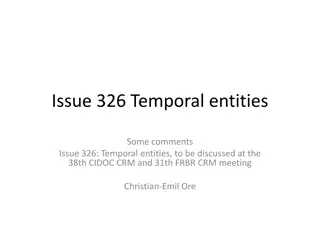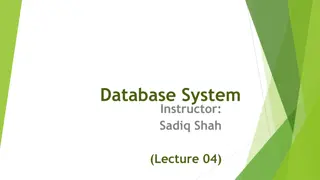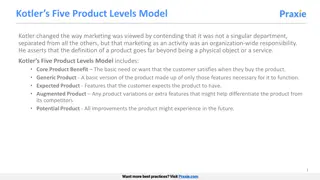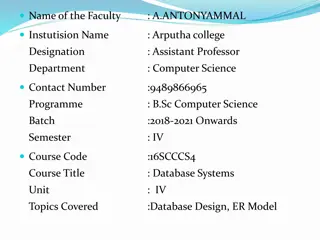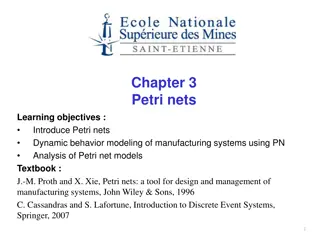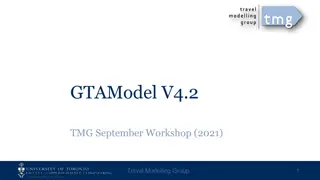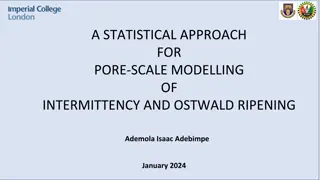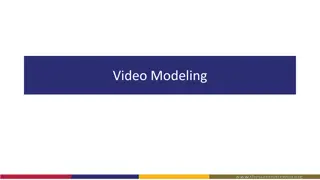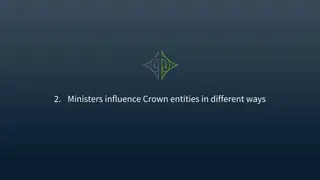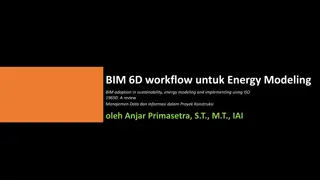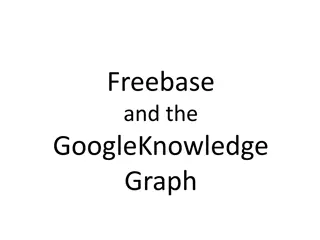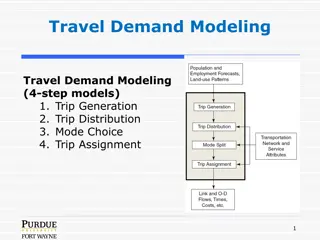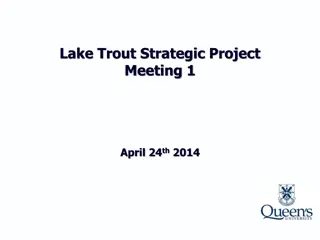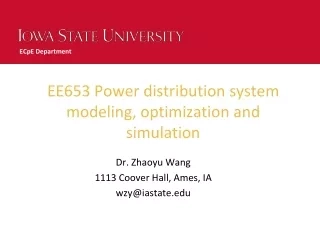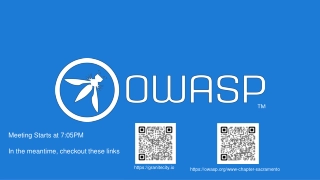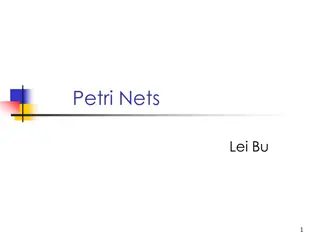Evolution of Product Entities: Modeling Approach Overview
Predicting the predecessor version of a product entity is crucial for understanding the evolution of products. Challenges such as lack of common naming conventions and unstructured product mentions are addressed through a two-stage approach involving parsing product names and clustering products based on brand and version. The proposed model aims to accurately identify the temporal order of product versions for entities like cameras and digital devices.
Download Presentation

Please find below an Image/Link to download the presentation.
The content on the website is provided AS IS for your information and personal use only. It may not be sold, licensed, or shared on other websites without obtaining consent from the author. Download presentation by click this link. If you encounter any issues during the download, it is possible that the publisher has removed the file from their server.
E N D
Presentation Transcript
Modeling the Evolution of Product Entities Priya Radhakrishnan1, Manish Gupta1,2, Vasudeva Varma1 1Search and Information Extraction Lab, IIIT-Hyderabad, India 2Microsoft, Hyderabad, India July 9, 2014 ACM SIGIR 2014 July 6-11, 2014 The 37th Annual International ACM SIGIR Conference priya.r@research.iiit.ac.in, gmanish@microsoft.com, vv@iiit.ac.in
Motivation Predict the previous version (predecessor) of a product entity Link various versions of a product in a temporal order Windows 7.0 > Windows 8.0 Helps study evolution of product entities Ubuntu 4.10 > Ubuntu 5.04 > Ubuntu 5.10 > Ubuntu 6.06 Install CD > USB > LiveCD Finding the predecessor of a product entity is the first step towards modeling the Evolution of Product Entities Modeling the Evolution of Product Entities (priya.r@research.iiit.ac.in) 2
A Typical Product Listing on Amazon Modeling the Evolution of Product Entities (priya.r@research.iiit.ac.in) 3
Challenges Deceptively easy task No common naming convention for versions or products Windows (3.0 > 95 > 98 > 2000 > XP > 7.0 > 8.0) Ubuntu (Warty > Hoary > Breezy > Dapper > Edgy ) Product mentions occur in unstructured natural language form JVC S-VHS Camcorder , Super VHS Camcorder , S VHS Camcorder Modeling the Evolution of Product Entities (priya.r@research.iiit.ac.in) 4
Proposed Approach Two stage approach Stage 1: Given a set of product entity names, we parse the product names to identify the brand, product and version indicating words from the product name Stage 2: Cluster products based on brand and product. Within a cluster, rank the version(s) in temporal order Modeling the Evolution of Product Entities (priya.r@research.iiit.ac.in) 5
A Two Stage Approach Stage 1 Input Output Leica D-Lux 6 digital camera 6 D-Lux digital camera Stage 2 Leica D-Lux Leica D-Lux 6 digital camera Leica D-Lux 4 digital camera Digital camera Leica D-Lux 5 4 5 6 Canon Canon A630 Canon A640 A630 A640 Modeling the Evolution of Product Entities (priya.r@research.iiit.ac.in) 6
Stage 1 Parsing the Product Title (1) Categorizing words in the product title as brand, product, version and other Conditional Random Fields (CRF) based approach CRF tagger is trained on manually labeled (word, label) pairs using 3 features Product description Context patterns surrounding the labels Linguistic patterns frequently associated with the labels Label words in product titles from the test set Given any query product version, we identify its (brand, product) Group together product entities that have the same brand and product as the given query Modeling the Evolution of Product Entities (priya.r@research.iiit.ac.in) 7
Stage 1 Parsing the Product Title (2) Feature Set Product description Description, weight, review, model, category, URL Context patterns Position of the word title, alphabet, numeral, parenthesis, previous word Linguistic patterns Words of the product title have POS tag (NNP, MD, VB, JJ, NN, CD, NNS, IN, RB, DT, VBP, VBD, CC, VBN, JJS, VBZ, LS, VBG, FW, PRP$, PRP, SYM) Modeling the Evolution of Product Entities (priya.r@research.iiit.ac.in) 8
Stage 2 Predicting Predecessor Version Members of a set of product entities with the same brand name and product name are candidates for being Predecessor version of query entity s version Classification based approach Binary features on Ordering Lexical : Does the candidate lexically precede the given query product version? Review-Date : Is the candidate older than the given query product version based on review date? Mentions : Was the candidate mentioned in the query product versions description or reviews? Nokia Lumia 1020 precedes Nokia Lumia 1320 by Lexical and Review-date features Modeling the Evolution of Product Entities (priya.r@research.iiit.ac.in) 9
Dataset Crawled 462K product description pages from www.amazon.com Labeled 500 from camera and photo category 40 out of the 500 product titles had predecessor version Modeling the Evolution of Product Entities (priya.r@research.iiit.ac.in) 10
Results Stage 1 Parsing the product title Label P R F Brand name 0.98 0.65 0.77 Product name 0.89 0.58 0.69 Version 0.69 0.48 0.55 Product name/Version 0.88 0.55 0.67 Others 0.84 0.98 0.91 CRF Accuracy for the Product Title Parsing Task Modeling the Evolution of Product Entities (priya.r@research.iiit.ac.in) 11
Results Stage 2 Predicting the Predecessor Version Feature TP FP P R F Lexical + Review- Date 0.632 0.049 0.533 0.632 0.578 All Features 0.579 0.049 0.512 0.579 0.543 Review-Date 0.579 0.061 0.458 0.579 0.512 Review-Date + Mentions 0.553 0.047 0.512 0.553 0.532 Lexical + Mentions 0.5 0.049 0.475 0.5 0.487 Lexical 0.5 0.056 0.442 0.5 0.469 Mentions 0.45 0.049 0.462 0.45 0.456 Classifier Accuracy for the Positive Class for Product Predecessor Version Prediction Modeling the Evolution of Product Entities (priya.r@research.iiit.ac.in) 12
Related Work Extracting attribute values for product entities 1. Mauge, Karin et al. Structuring E-Commerce Inventory. ACL 12 2. Putthividhya, Duangmanee et al. Bootstrapped Named Entity Recognition for Product Attribute Extraction. EMNLP 11 Identifying related entities 3. N. Bach and S. Badaskar. A Survey on Relation Extraction LTI CMU 2007 4. L. Fang, A. D. Sarma, C. Yu, and P. Bohannon. REX: Explaining Relationships Between Entity Pairs. PVLDB, 5(3):241252, Nov 2011 None of the above works focus on extracting the version information from the product listing titles, which we have accomplished in the proposed work Modeling the Evolution of Product Entities (priya.r@research.iiit.ac.in) 13
Conclusion A two-stage approach to find the predecessor of a product entity First stage achieved a precision of ~88% Second stage achieved a precision of ~53% Applications Product search engine ranking Comparing product versions Modeling the Evolution of Product Entities (priya.r@research.iiit.ac.in) 14
Future Directions We plan to enhance this work as follows For building product version trees Studying how features of product entities evolve Code https://github.com/priyaradhakrishnan0/EntityRanking Golden dataset IIIT-H Internal Link http://10.2.4.116/backup/sieldata/datasets/EntityRanking/data.zip External Link http://tinyurl.com/lclapy8 Modeling the Evolution of Product Entities (priya.r@research.iiit.ac.in) 15
Thank you for your time and attention Modeling the Evolution of Product Entities (priya.r@research.iiit.ac.in) 16






